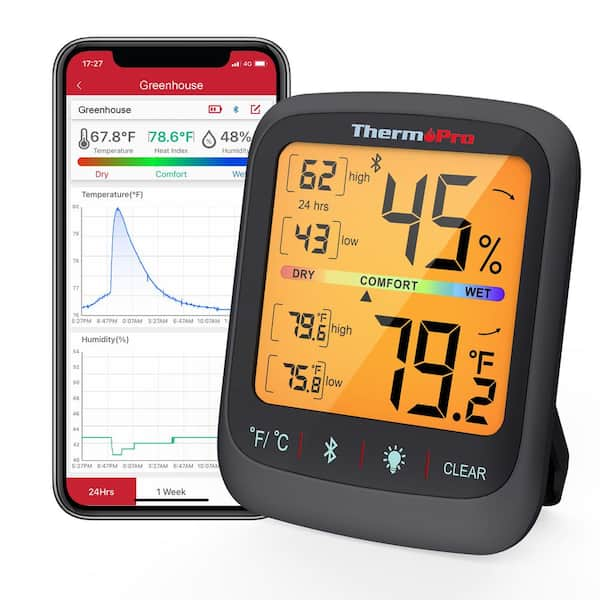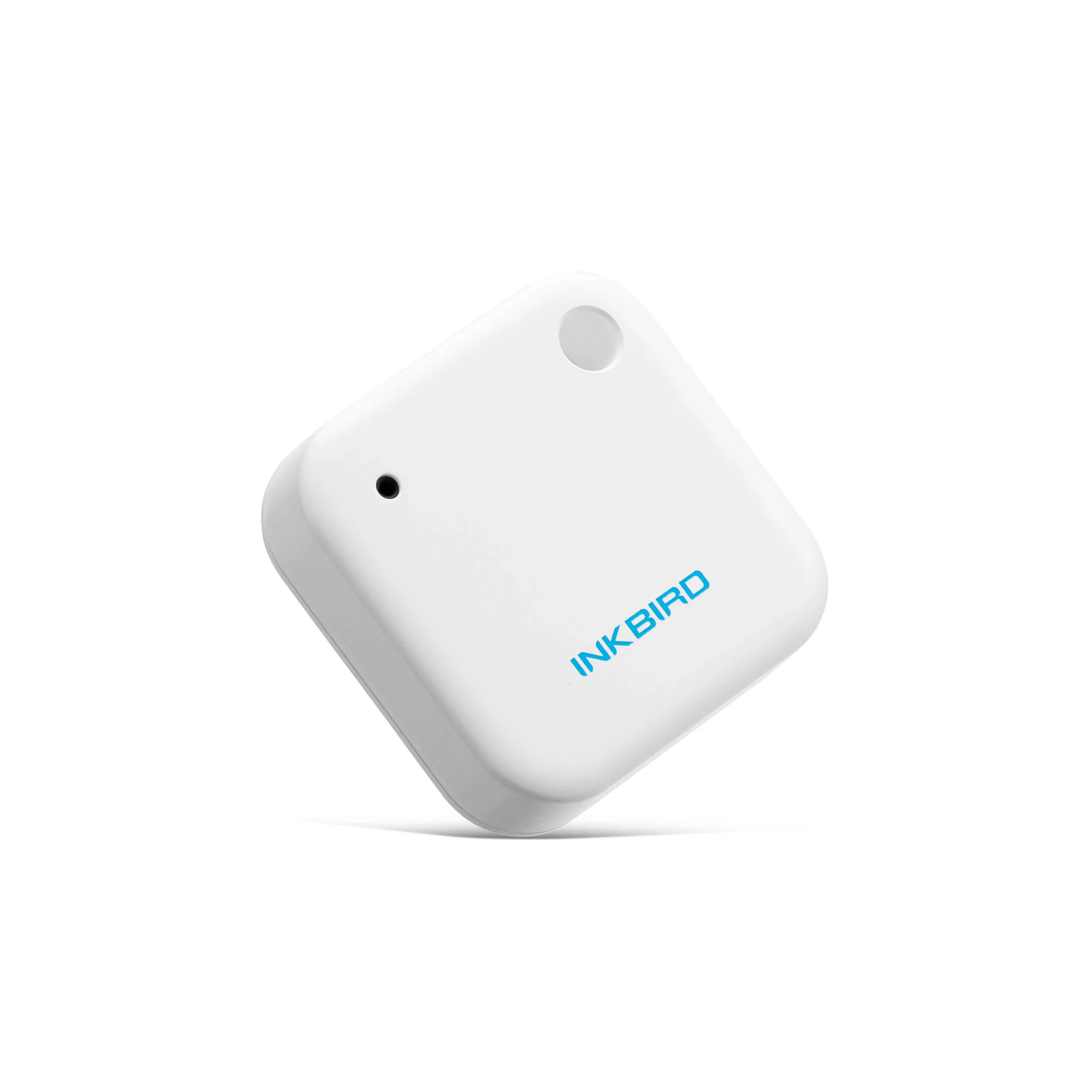Are you struggling to choose the right tool to monitor your environment’s humidity? You might have come across two popular options: wireless hygrometers and Bluetooth hygrometers.
Both promise convenience, but which one truly fits your needs? Understanding the key differences can save you time, money, and frustration. Keep reading to discover how these devices work and which one will give you the best control over your space.
Your perfect humidity monitor is closer than you think.

Credit: www.homedepot.com
Wireless Hygrometer Basics
Wireless hygrometers measure humidity without using wires. They give real-time data by sending signals to devices. These tools help monitor air moisture in many places. Their wireless feature adds convenience and flexibility.
Understanding wireless hygrometers helps you choose the right device. Learn how they work, where to use them, and their benefits.
How Wireless Hygrometers Work
Wireless hygrometers use sensors to detect moisture in the air. The sensor sends data to a transmitter inside the device. This transmitter sends the information wirelessly to a receiver or app. The receiver shows humidity levels on a screen or phone. Some models also measure temperature along with humidity.
Common Uses And Applications
These devices are popular in homes, greenhouses, and warehouses. They help keep plants healthy by monitoring humidity. In homes, they prevent mold by tracking moisture. Warehouses use them to protect goods from damage. Labs and museums also rely on them to keep conditions stable.
Advantages Of Wireless Technology
Wireless technology removes the need for cables and wires. It allows easy placement of sensors anywhere in a space. Users can check humidity from a distance using phones or computers. Wireless devices often have long battery life. They reduce clutter and make monitoring simple and quick.
Bluetooth Hygrometer Features
Bluetooth hygrometers offer smart features that make monitoring humidity easy and precise. These devices connect directly to your smartphone. They give real-time data and alerts. This helps you keep the air quality just right.
Bluetooth Connectivity Explained
Bluetooth technology allows the hygrometer to link with your phone. It creates a wireless connection within a short distance. This means no wires or complicated setups are needed. The device sends humidity data smoothly and quickly.
Mobile App Integration
Most Bluetooth hygrometers work with a dedicated mobile app. The app shows current humidity and temperature readings. It also stores past data for easy review. You can set alerts for high or low humidity levels. This helps you act fast to protect your space.
Range And Signal Strength
The Bluetooth signal usually works within 30 feet indoors. Walls and furniture can reduce the range. Stronger signals ensure reliable data transfer. Check the device specs for exact range details. Good signal strength keeps your readings consistent.
Accuracy Comparison
Accuracy matters most in measuring humidity. Both wireless hygrometers and Bluetooth devices offer reliable readings. Differences exist in how they detect and report humidity levels. Understanding these differences helps in choosing the right device for your needs.
Sensor Technology Differences
Wireless hygrometers usually use capacitive sensors. These sensors measure humidity by detecting changes in electrical capacitance. Bluetooth devices may use the same or different sensors, like resistive or thermal sensors. Capacitive sensors tend to be more stable and less affected by temperature changes. Sensor type impacts the precision and consistency of readings.
Calibration Methods
Calibration ensures sensors give accurate readings. Wireless hygrometers often require manual calibration using salt solutions or reference devices. Bluetooth devices may offer automatic calibration through connected apps. Regular calibration keeps both devices accurate over time. Without it, readings can drift and become unreliable.
Real-world Performance Tests
Tests in homes and offices show small accuracy gaps. Wireless hygrometers generally have steady readings in stable environments. Bluetooth devices can provide real-time updates and alerts via smartphones. Both perform well within a few percentage points of actual humidity. Environmental factors like airflow and temperature affect results more than device type.

Credit: www.amazon.com
Power And Battery Life
Power and battery life play a big role in choosing between a wireless hygrometer and a Bluetooth model. These devices need reliable energy to work properly and give accurate readings. Understanding how they use power helps you pick the right one for your needs.
Battery Types Used
Wireless hygrometers often use small batteries like AAA or AA. Some models use coin cell batteries. Bluetooth hygrometers usually have rechargeable lithium-ion batteries. These last longer but need charging. Battery type affects device size and weight.
Energy Efficiency Factors
Wireless hygrometers are simple and use less power. They send data less often, saving energy. Bluetooth devices use more power due to constant connection. Energy-saving modes in Bluetooth models help extend battery life. Screen brightness and sensor frequency also impact efficiency.
Charging And Replacement
Wireless hygrometers need battery replacement after months of use. Replacing batteries is easy and quick. Bluetooth hygrometers require charging, often via USB cables. Charging time varies from one to several hours. Some Bluetooth devices have removable batteries for easy swap.
Data Management And Alerts
Managing data and receiving alerts are crucial features in both wireless hygrometers and Bluetooth devices. These functions help users track humidity and temperature over time. They also warn users of any sudden changes that may affect sensitive environments. Understanding how these devices handle data and alerts can guide you in choosing the right tool for your needs.
Data Logging Capabilities
Wireless hygrometers often store data internally or send it to a connected app. They record humidity and temperature at set intervals. Bluetooth devices typically log data directly on your phone or tablet. Both options let users review past readings easily. This helps spot trends and ensure stable conditions.
Alert Systems And Notifications
Alerts notify users when humidity or temperature go beyond set limits. Wireless devices can send instant notifications to your phone or email. Bluetooth models usually alert through app notifications or sound alarms. These alerts help prevent damage to goods or equipment by prompt action.
Cloud Storage Options
Many wireless hygrometers offer cloud storage for data backup. This allows access to historical data from any device with internet. Bluetooth devices may also sync data to the cloud via their apps. Cloud storage keeps data safe and easy to share with others.

Credit: inkbird.com
Cost And Value
Cost and value play a big role in choosing between a wireless hygrometer and a Bluetooth model. Both offer benefits but differ in price and features. Understanding these differences helps you pick the best option for your needs and budget.
Price Range Comparison
Wireless hygrometers usually cost less than Bluetooth models. Basic wireless devices start around $20 to $50. Bluetooth hygrometers often range from $40 to $100 or more. The higher price reflects added features like app connectivity and data tracking. Simple wireless models suit small budgets. Bluetooth options fit those wanting more control and data access.
Long-term Investment Considerations
Think about how long you plan to use the device. Wireless hygrometers have fewer tech parts, often lasting longer. Bluetooth models may need updates and battery replacements. Some users save money over time with wireless units. Others prefer Bluetooth for detailed monitoring, justifying the cost. Consider your needs and how much you want to spend over years.
Warranty And Support
Check the warranty for each device. Wireless hygrometers usually offer one-year coverage. Bluetooth devices may offer similar or longer warranties. Customer support varies by brand. Some provide easy returns and helpful guides. Others may be less responsive. Good warranty and support add value and protect your purchase.
Choosing The Right Device
Choosing the right device between a wireless hygrometer and a Bluetooth hygrometer is important. Each device offers different benefits. Picking the best one depends on your needs, budget, and how you plan to use it. Understanding these differences helps you make a smart choice.
Key Factors To Consider
Look at the range of the device. Wireless hygrometers usually work over longer distances. Bluetooth devices need to be close to your phone or tablet. Check battery life. Longer battery life means less hassle. Also, consider how easy it is to read the data. Some devices have simple screens; others use apps. Think about your budget. Wireless models can cost more.
Best Use Cases For Each Type
Wireless hygrometers work well for large spaces like greenhouses or warehouses. They send data over long distances. Bluetooth hygrometers suit smaller spaces or personal use. They connect directly to your phone for quick checks. If you need alerts or data logging, Bluetooth is handy. Wireless devices fit better where you cannot always be nearby.
Tips For Maximizing Accuracy
Place the device away from direct sunlight and heat sources. Keep it in a stable spot, not near windows or vents. Calibrate the device regularly for better readings. Avoid placing it near electronics that may cause interference. Clean the sensor gently to prevent dust buildup. Follow the manufacturer’s instructions for best results.
Frequently Asked Questions
What Is The Main Difference Between Wireless And Bluetooth Hygrometers?
Wireless hygrometers transmit data over longer distances using radio frequencies. Bluetooth hygrometers connect directly to nearby devices within a shorter range. Both measure humidity but differ in connectivity and range, influencing their ideal use cases and convenience.
Which Hygrometer Type Offers Better Real-time Monitoring?
Bluetooth hygrometers provide better real-time monitoring. They connect instantly to smartphones or tablets, allowing quick access to data. Wireless hygrometers may have delays due to longer transmission distances and network setups, making Bluetooth more suitable for immediate humidity tracking.
Are Bluetooth Hygrometers More Energy Efficient?
Yes, Bluetooth hygrometers are generally more energy efficient. They use low-energy Bluetooth technology designed for minimal power consumption. Wireless hygrometers often require more power for longer-range data transmission, which can reduce battery life and increase maintenance frequency.
Can Wireless Hygrometers Cover Larger Areas Than Bluetooth?
Yes, wireless hygrometers cover larger areas effectively. They use radio frequencies that allow data transmission over greater distances. Bluetooth devices have a limited range, typically around 30 feet, making wireless hygrometers better for monitoring multiple rooms or large spaces.
Conclusion
Wireless hygrometers and Bluetooth devices both measure humidity well. Wireless models offer easy placement without cables. Bluetooth devices connect quickly to smartphones for real-time data. Each has pros depending on your needs. Choose based on how you plan to use it.
Both improve monitoring in homes or workplaces. Simple technology meets convenience in both options. Understanding features helps pick the right tool. Keep your environment comfortable with accurate humidity readings. The choice depends on your lifestyle and budget.



